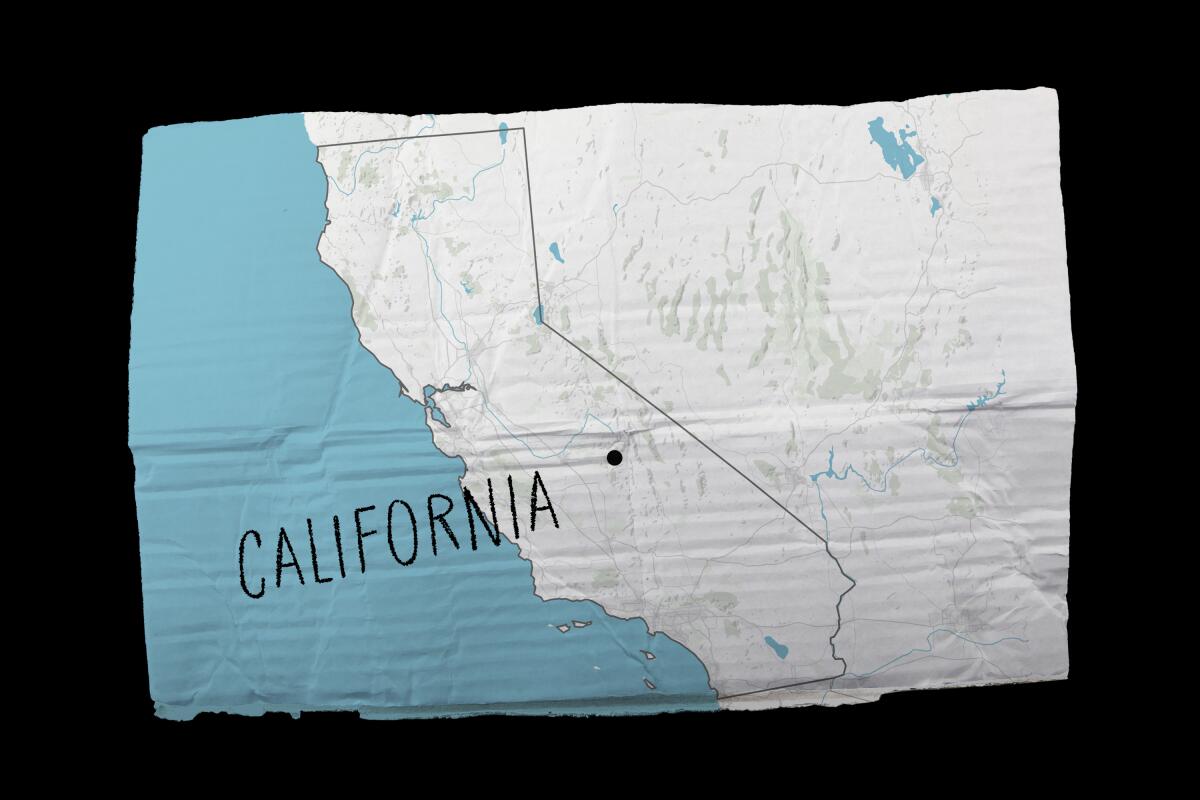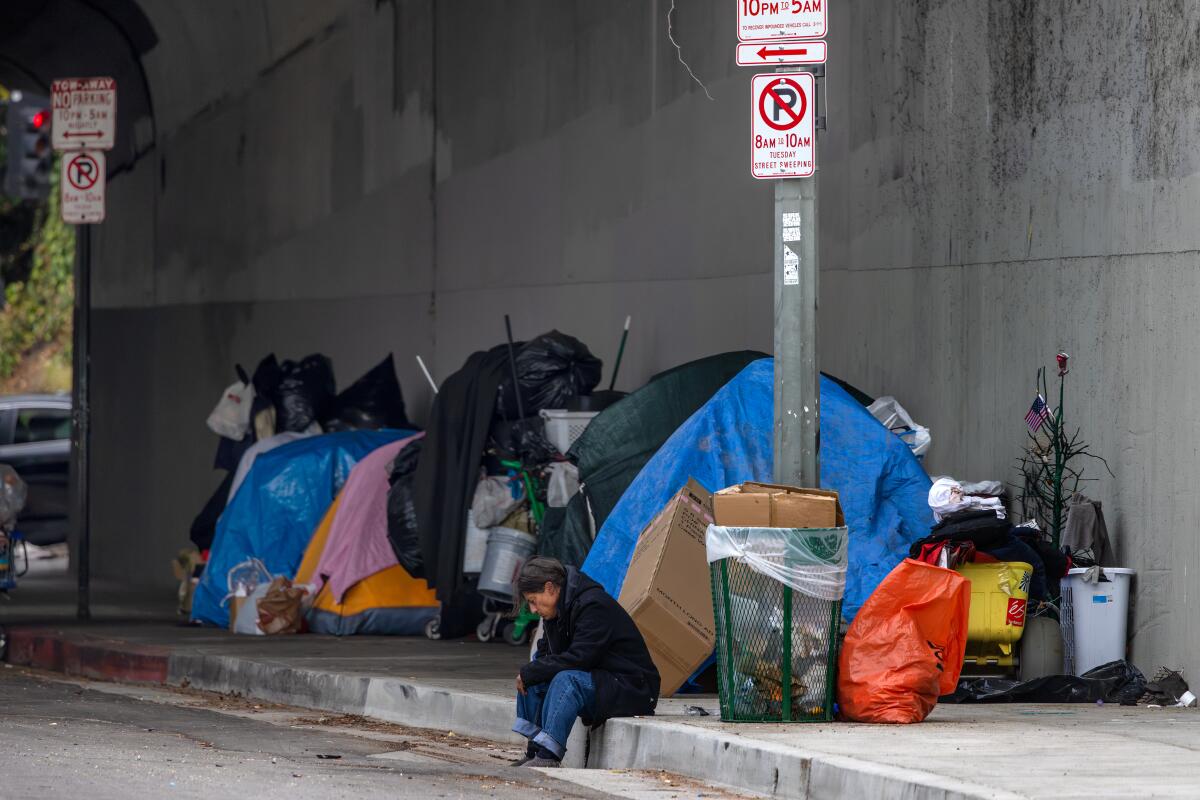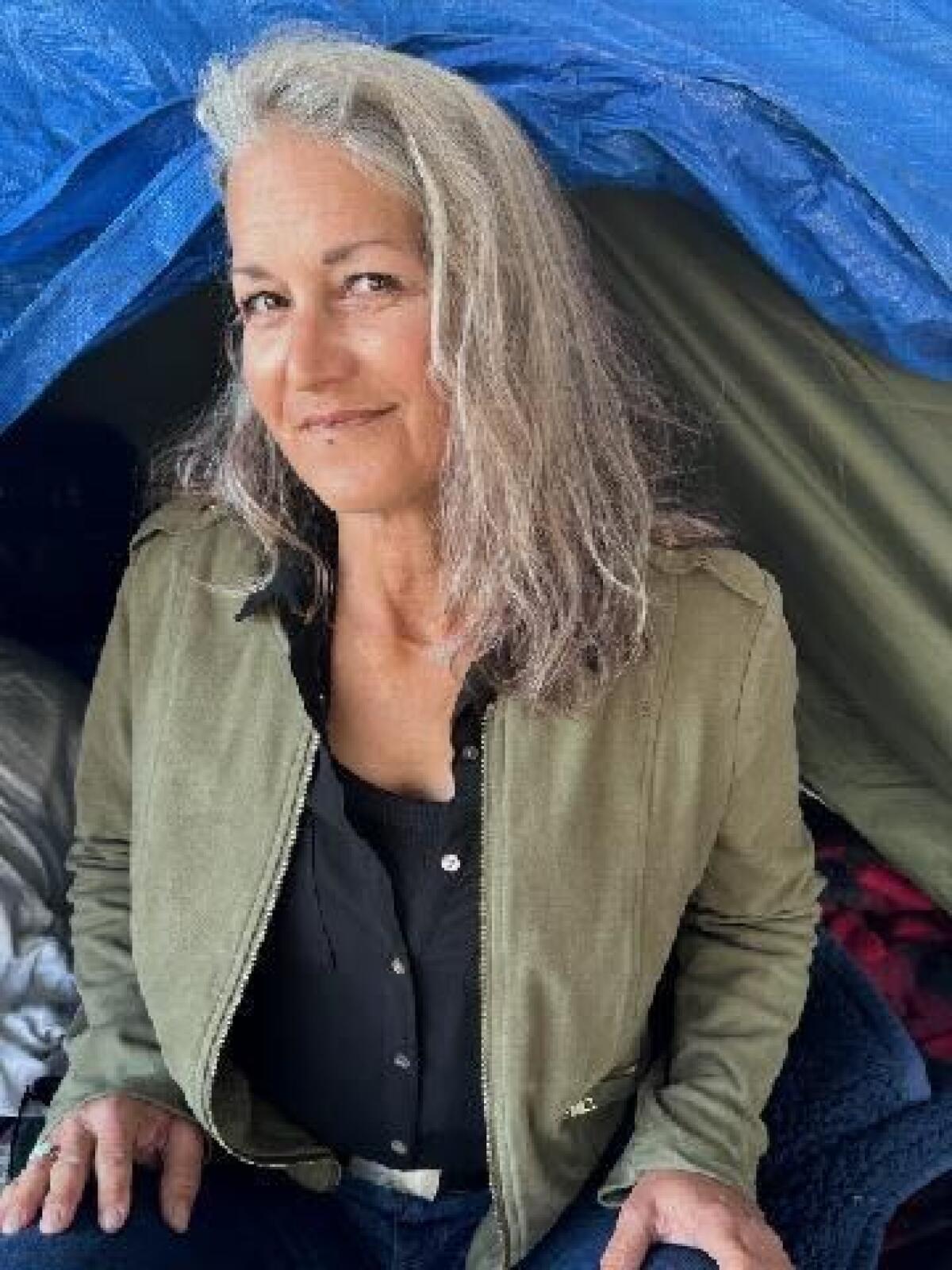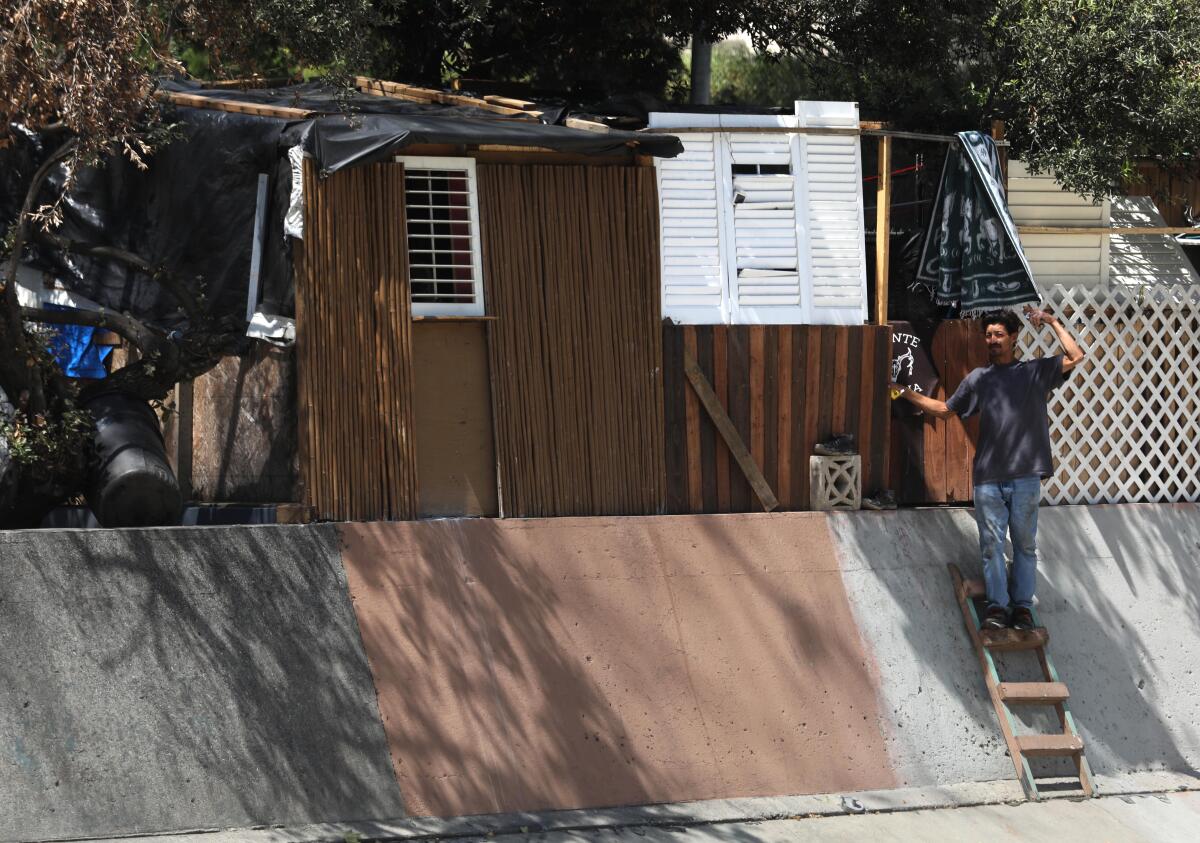California is the U.S. capital for homelessness. What will it take to turn that around?

Good morning. It’s Monday, April 22. Here’s what you need to know to start your day.
- The systems that respond to homelessness are broken. Can they be fixed?
- Tribal leaders see a “symbol of hope” in the roughly 500,000 salmon released into the Klamath River.
- A federal subsidy that helps millions of Californians access the internet is slated to expire in May
- And here’s today’s e-newspaper
You're reading the Essential California newsletter
Our reporters guide you through our biggest news, features and recommendations every morning
You may occasionally receive promotional content from the Los Angeles Times.
Three cities offer hope on California’s homelessness crisis
After roughly 11 years living on the streets of San Diego, Rachel Hayes moved into an apartment last summer. But adjusting to the roof over her head has been a process. For a while she’d wake up every few hours in the night, unfamiliar with the stillness, solitude and quiet of her own space. She even returned to her tent to sleep on the street some nights.
She felt lucky — and a little guilty — to have a home again when so many of her friends and neighbors don’t.
“I shouldn’t be the only person on this block to get housing,” she said. “If it takes 10-plus years to get housing, there’s something wrong in the system … it’s fixable, but it’s broken.”
California leads the nation in homelessness
Despite tens of billions of dollars allocated in recent years, homelessness has worsened.
The state’s homeless population has climbed 40% over five years. The latest federal estimates show more than 181,000 Californians were unhoused in 2023, with nearly 70% living on the streets.
About half of all unsheltered people living in the U.S. live in the Golden State, according to the California state auditor’s office, which summed up the problem plainly:
“We build only a fraction of the affordable housing residents need.”
And if you thought the state was diligently tracking the outcomes of the programs all those billions fund, my colleague Mackenzie Mays has some bad news for you.
“I’m not interested in funding failure any longer,” Gov. Gavin Newsom said last week. “I want to see results. Everybody wants to see results.”
The systems that respond to homelessness are not working
I spent months speaking to people in power, people doing what they think can help their unhoused neighbors and people who’ve forged a path into housing for themselves.
Everyone told me a version of the same thing: The systems meant to respond to and reduce homelessness mostly fail to get people on paths to secure housing. They pointed to government ineptness, entrenched political inertia or forces beyond local control such as the global pandemic.
“We’re at a place in California, unfortunately, where doing well is often running in place,” said Margot Kushel, a professor of medicine and director of the Benioff Homelessness and Housing Initiative (BHHI) at UC San Francisco.
Cities can pour more resources into the emergency solutions, such as new and larger temporary shelters, Kushel said. That could “remove the problem from the public eye” and might look like an improvement in a city’s metrics.
“But [it’s] not really,” Kushel told me. “And everyone is still homeless.”
A supreme court case could change the equation

In rulings over the last nearly 20 years, the U.S. 9th Circuit Court of Appeals has said that arresting or fining people who have no access to shelter violates the 8th Amendment’s ban on cruel and unusual punishment.
If the Supreme Court reverses the 9th Circuit in a case lawyers are arguing today, city officials and their police forces in the Western states could remove homeless encampments from sidewalks, parks or other public areas.
But moving homeless people around is different than solving homelessness.
A consensus is growing: The problem is housing
While mental health issues and substance abuse play a major role, ultimately it’s poverty that deepens the spiral for people living on the streets. The growing consensus from experts, advocates and government officials is that increasing affordable housing is the key to reducing homelessness.
“In 2023, California had only 24 units of housing available and affordable for every 100 extremely low-income households,” BHHI researchers noted in a recent study.
My colleagues have been diligently reporting on the relationship between housing and homelessness.
Some examples:
- California is building fewer homes. The state could get even more expensive.
- California spent billions on homelessness without tracking if it worked.
- The truth about our homelessness crisis: As Californians age, they are priced out.
- The Times’ investigations into Skid Row’s troubled housing providers.
- Why clearing encampments became harder in California than most other states.
And there’s more to unpack.

A broken but fixable system?
When I checked in with her months later, Rachel Hayes had an update: she’d packed up her tent and is living in her apartment with her boyfriend full time. She continues to visit her friends, and advocate for the city to house them.
“It should be a constitutional right to have housing, no matter what the circumstances are,” she said. “We have people’s grandparents living out here. We have young people [like] my neighbor. She’s pregnant. She’s on the streets. That’s inexcusable.”
Rachel hopes that she can heal from the trauma of over a decade of living outside.
“You can’t show weakness on the streets; you always have to be in survival mode and constantly be aware of everything around you,” she told me. “There are times I want to run from housing back to what I’ve known for over the past 10 years. [But] housing is giving me the foundation to fix me.”
Over the next three days, I will take you on a journey across California to unpack what I heard from Rachel and others about the system itself: that it’s broken — but “fixable.”
We’ll head to:
- Bakersfield, where an intense focus on new metrics helped the city and county solve homelessness. It just didn’t last.
- San Diego, where some business leaders are floating their own solution.
- Sacramento, where the unhoused community unionized and signed a first-of-its-kind lease with the city.
Today’s top stories

Climate and environment
- California tribal leaders see a “symbol of hope” in the roughly 500,000 salmon the state has released into the Klamath River. That hope could be realized in a few years when the salmon make their way back upstream a revitalized river.
- California wants to harness more than half of its land to combat climate change by 2045.
- New scientific interventions are here to fight climate change. But they aren’t silver bullets.
- A new study has found that climate change supercharged a heat dome, which intensified the 2021 fire season.
- A Santa Monica elementary school has plans to modernize its campus. Then toxic dry cleaning chemicals were found in the soil.
State, local and national politics
- Gov. Gavin Newsom is calling out Republican abortion policies in a new TV ad running in Alabama.
- A federal subsidy that helps nearly 3 million Californians and millions more households across the U.S. connect to the internet is slated to expire in May.
- L.A. Mayor Mayor Bass’ ambitious housing program calls on the city’s wealthy. Can she pull it off?
- The House votes for possible TikTok ban in the U.S., but don’t expect the app to go away any time soon.
Festival of Books
- Some writers and readers wrestle with tough subjects at the 29th event.
- Check out the best portraits from the festival, including Henry Winkler, Octavia Spencer and Mark Harmon.
- Poet Victoria Chang touches on feminism, grief and art.
More big stories
- The Supreme Court hears a case today that could upend California’s homelessness policies.
- Inside an Arizona abortion clinic: uncertainty looms and optimism reigns.
- Police responded to an alarm around the time of a $30-million heist, but thieves were undetected.
- A suspect was arrested in a break-in at L.A. Mayor Karen Bass’s home.
Get unlimited access to the Los Angeles Times. Subscribe here.
Commentary and opinions
- George Skelton: California’s budget relies on the richest taxpayers, and we’re paying the price.
- Robin Abcarian: Here’s how antiabortion absolutists plan to drag California back to the 19th century.
- Mark Z. Barabak: Kevin McCarthy wants vengeance. Now he’s free to pursue it.
- Opinion: USC got it wrong in canceling valedictorian’s speech. Here’s what the school should do now.
Today’s great reads

Along the 110 Freeway, a set of encampments built from repurposed housing materials epitomize the L.A. homelessness crisis. Times reporter Nathan Solis visited and spoke with immigrants who have fashioned their own home in gentrifying Highland Park, finding sanctuary “at a time when so many throughout the region are struggling to get by.”
How can we make this newsletter more useful? Send comments to [email protected].
For your downtime

Going out
- 🛏️ What is it like to live in an L.A. hotel? Here’s a glimpse.
- 🥁 USC Thornton’s Chamber Music Festival is happening this week. Catch winds and percussion at Monday’s free performances.
- 🎞️ Provocative ‘Civil War’ prevails at the box office in its second weekend.
Staying in
- 📺 Good news for “Bluey” fans: following last week’s special “The Sign,” a new episode is available now on Disney+.
- 🧑🍳 Here’s a recipe for chocolate sheet cake.
- ✏️ Get our free daily crossword puzzle, sudoku, word search and arcade games.
And finally ... a great photo
Show us your favorite place in California! We’re running low on submissions. Send us photos that scream California and we may feature them in an edition of Essential California.

Today’s great photo is from Kevin Smalley of West Hollywood: a tiny spotted visitor enjoying Refugio State Beach, in Goleta, Calif.
Kevin writes: “A camping trip to Refugio State Beach in Goleta, CA, provided tons of rock formations, tide pools, palms, and reliable breathtaking sunsets to photograph. But my favorite shot happened when I sat down near the water’s edge to simply admire the view. It seemed so unexpected to find the polka dot creature crawling among sea glass and kelp!”
Have a great day, from the Essential California team
Ryan Fonseca, reporter
Joe Mozingo, deputy Metro editor
Karim Doumar, head of newsletters
Check our top stories, topics and the latest articles on latimes.com.
Sign up for Essential California
The most important California stories and recommendations in your inbox every morning.
You may occasionally receive promotional content from the Los Angeles Times.




